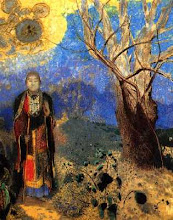Here is my second Faithbook post from February 16th 2008.
In the religious studies department of the University of Iowa, the graduate students are required to take a series of four foundational courses regardless of their area of specialization. During my first semester at UIowa I took Teaching Religious Studies; the next semester it was Western Religious Traditions; then Methods and Theories; and finally, this semester I am finishing up with Asian Religious Traditions.
What makes these classes a bit strange is that students who have devoted a great deal of time to becoming experts in a particular field sit next to other grad students for whom the material is brand new. I struggled through much of Methods and Theories (reading Bourdieu, Asad and Gadamer) while my friends specializing in Biblical Studies or Modern Religious Thought are now struggling through Asian Traditions.
The other day, our professor was away at a conference so we watched a wonderful documentary called Footprint of the Buddha from The Long Search series. After the video, we had instructions to "discuss Theravāda Buddhism," but I quickly realized that there were only two of us in the room (out of twenty students) who knew enough about the material to even thrash out the basics. My classmate P.J. and I made our way to the front of the room--dry-erase markers in hand--and began taking questions from the class.
Where does one begin when teaching about this thing that we call Buddhism? Do you start with names, dates and controversies? Was the Buddha an actual person, or the name we ascribe to a tradition of teachers? If he was in fact a real individual, what are the accurate dates of his birth, ministry and death? Which text best reflects the "actual" or "authentic" teachings of the Buddha? Was the Buddha's attitude towards the nun's order sexist or cautious? Is Theravāda Buddhism really a selfish path to individual salvation as many Mahāyānists believe, or does the Pali Canon contain all the seeds of later teachings as is averred by monks like Thich Nhat Hahn? Why does the Theravāda path seem to reject (or limit) the use of iconography, ritual, and devotion to deities and gurus, while the Vajrayāna path makes these practices central?
P.J. and I decided that it was best not to delve into these issues until our fellow grad-students had a grounding (however shallow) in the basic doctrinal tenants shared by the majority of Buddhist denominations across time and geography. We began to fill the board with descriptions of the four noble truths, the eight-fold path, the three jewels, the ten precepts, the five skandas, the three characteristics and the three poisonous roots. We explained the words Theravāda, Buddha, Bodhisattva, Dalai Lama and Tulku. It wasn't long before the white-board looked as if we were trying to solve the world's strangest mathematical equation. Or like Jackson Pollock had been reincarnated in Iowa City and decided to take up his action-paintings again. Either way, it was a total mess and a thing of beauty.

On the one hand, I can see how all these lists and details can be overwhelming to the newcomer to Buddhism. (Or to the seasoned practitioner who just wants to "sit"). On the other hand, I am constantly struck by the beauty and symmetry of all these interrelated concepts. The four noble truths only really begin to make sense when one knows that suffering is driven by the three poisons (ignorance, greed and hatred). One's ability to bravely walk the eightfold path is deepened by an understanding of monastic law and the precepts. Right Mindfulness and Right Concentration (noble path #7-8) becomes easier when you know what to take as your object of meditation, namely the three characteristics of all things: non-self, impermanence and suffering.
It's as if the Buddha Dharma is ecological in both its form and content. The content of the Dharma stresses the fact that everything in the world is intimately interconnected, with all things arising and falling in tandem with everything else. While the actual form of the Dharma makes the same point in a more iconographic way, by expressing a conceptual ecology: ideas in sympathetic relationship with each other. The form of the Dharma, when graphically mapped resembles a mandala in which every teaching is dependent on all the others and only when the parts are taken together do they form a balanced and organic whole.
A recent book that tackles the idea of Buddhism's "conceptual ecology" is Mapping the Dharma: A Concise Guide to the Middle Way of the Buddha, by Paul Gerhards. I recommend this book to those who feel that the teachings must by definition get in the way of practice. I like to think that one should neither have teaching without practice or practice without teaching. Neither should you have compassion without wisdom or wisdom without compassion. To ignore either means to take a part for the whole, and that, I believe is the problem of suffering in a nutshell.



Through Google Alerts I've discovered your blog and your recommendation of my book, Mapping the Dharma. I'm glad you found it useful enough to recommend, and I thank you for doing so.
ReplyDeleteKindly,
Paul Gerhards
Are you sure Jackson Pollock didn't reincarnate in Iowa City?
ReplyDelete